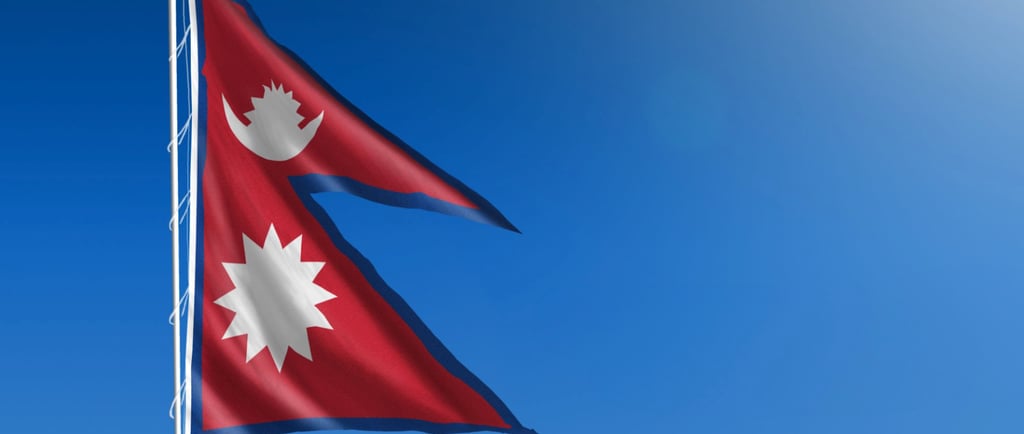🏔️ The Flag of Nepal: The Tallest Peak and Pride 🇳🇵
A flag story invites children into the fascinating world of symbols, colors, and shapes that represent countries around the globe. 🌍🇦🇺🇫🇷 In "Flags of the World," each flag reveals a story—of ancient legends, natural landscapes, and the hopes and dreams of a nation’s people. 🌞🏔️ This exploration encourages children to see flags not only as symbols but as connections to the world’s shared heritage, inspiring questions like, “Why these colors?” and “What does this symbol mean?”
GEOGRAPHY STORIES
11/8/20243 min read


Nepal’s flag is unlike any other in the world—it’s the only flag that isn’t a rectangle! Its unique design, shaped like two triangles, reflects the special spirit of the mountainous country it represents.
🔺Nepal’s flag is made of two stacked triangles, which represent the Himalayan mountains—including Mount Everest, the tallest peak on Earth! These triangles also stand for the bravery and resilience of the people of Nepal, who are known for their strength in the face of challenges.
🔴⚪The flag is red with a blue border. Red is the color of bravery and is also the color of the Rho-do-den-dron 👏👏👏👏, Nepal’s national flower. The blue border represents peace and harmony, values held close by the people of Nepal.
🌞🌙 On the triangles, you’ll find symbols of both the sun and the moon. The moon represents calmness and the gentle nature of the Nepali people, while the sun stands for fierce determination and energy. Together, these symbols mean that Nepal will last as long as the sun and moon shine in the sky.
🧝 One legend says that the sun and moon were placed on the flag by the gods to watch over Nepal. The story tells that when the first settlers came to the land, they asked the gods for a sign that would protect them and guide their future. In response, the gods sent down the sun and moon to rest on Nepal’s flag as symbols of eternal protection and strength. The people believed that as long as the sun and moon appeared on the flag, Nepal would remain a safe and blessed land.
📜 Nepal’s flag has existed in various forms for centuries, but the current design was officially adopted 50 years ago. It is based on ancient designs that date back to Nepal’s royal dynasties and reflects the country’s rich history and unique place in the world.
🎉 Nepal celebrates Constitution Day every year on September 20, a day to honor the flag and reflect on the country’s values and unity. On this day, Nepalis take pride in their flag, a symbol of strength, peace, and a connection to their homeland.
So, whenever you see Nepal’s flag 🇳🇵, remember it’s not just a unique shape but a symbol of towering mountains, a strong and peaceful spirit, and the timeless protection of the sun and moon, as told in the legend of Nepal. And there are other flag stories which you can find in the Geography shelf.
Follow-Up Projects 🌍🏳️🌈
🎶 National Anthem: Nepal’s anthem, “Sayaun Thunga Phoolka,” celebrates the land’s beauty and unity. Listen to how it sounds with traditional Nepali instruments like the madal drum and bansuri flute! How is it different from other anthems you’ve heard? What does the anthem say about Nepal’s values?
🥘🦜🌲 National Symbols: Did you know Nepal’s national bird is the colorful Himalayan Monal? Or that the national flower, the rhododendron, brightens up the mountains with its red blossoms? Discover why the cow is honored as the national animal and why people love eating dal bhat! What do these symbols tell us about Nepal’s traditions and nature?
✍️ Write Flag Stories: Imagine creating your own story about a country’s flag! Choose any flag that fascinates you and think about its colors and symbols. What do they mean to you?
🗺️ Note for Flag Presentations:
I will present one story for a flag, while the rest of the flag stories will be printed as materials for the Geography shelf. When sharing a flag story, I’ll use a map to show where the country is located, helping children connect the flag with the country's geography and understand its place in the world. This approach not only gives context to each story but also encourages children to explore maps, learn about continents and countries, and discover how geography shapes culture.
With Montessori joy,
Vanina 😊

